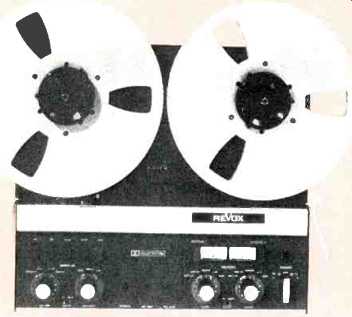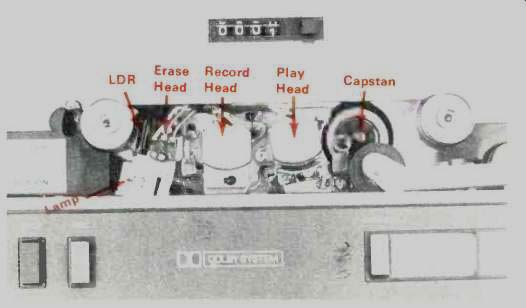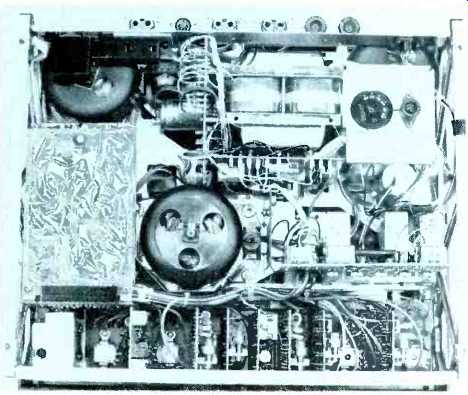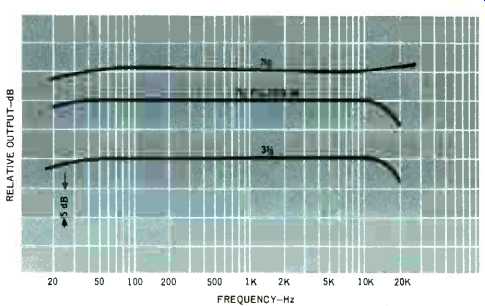
MANUFACTURER'S SPECIFICATIONS
Tape Speeds: 7 1/2 and 3 3/4 ips, 0.2%.
Motors: Three, electronically governed capstan motor, electronic speed change.
Wow and Flutter (weighted): Max. 0.08% at 7 1/2 ips; max. 0.1 at 3 3/4 ips.
Operating Position: Horizontal or vertical.
Frequency Response: 30-20,000 Hz +2, -3 dB at 7 1/2 ips; 30-16,000 Hz +2,-3 at 3 3/4 ips. Distortion at Full Modulation, 1000 Hz: Max. 1 1/2% at 7 1/2 ips; 2% at 3 3/4 ips (with Dolby). Signal to Noise Ratio: Better than 58 dB at 7 1/2 ips, better than 56 dB at 3 3/4 (w. Dolby)
Oscillator Frequency: 120 kHz. Power Supply: Electronically stabilized. Tape Spool Diameter: Max. 101 in.
Dimensions: 16 1/4 in W, 14 3/4 in. H, 8 3/4 in. D, (over controls).
Weight: 34 lbs.
Price: $859.00.
Whatever we said about the original Revox A77 in October, 1968, could well he repeated here, except that this model is better-being Dolby equipped. There are a few minor differences in appearance and a few in the mechanism itself. The upper portion of the unit-behind the tape reels--now has a stainless steel front over the plastic main panel, whereas the original was dark gray plastic. The lower portion of the first model was brushed stainless steel, while the current model has a dark gray plastic panel. There are two toggle switches below the controls--the one on the left switches the Dolby circuit in or out in both record and play modes, and the one at the right switches in or out a filter to eliminate interference from stereo multiplex circuitry.
The original machine had a pair of push-push switches to cut off power to the spooling motors and to disconnect the input to the power amplifiers (when included). These have been eliminated and in their place are the two Dolby calibration controls. The monitor-selector switch formerly had three positions for INPUT, tape (NAB) and tape (TEC). The TEC position has been replaced by a CAL position which turns on the calibration oscillator for the Dolby circuitry and enables the adjustment of the proper levels for correct Dolby operation.
The solid tape guide post has been replaced by a spring loaded guide post to further eliminate flutter due to varying tape tension in the feed reel, and the left tape guide--formerly a solidly fixed non-rolling roller--is now actually a roller. The right tape guide is still fixed.
The space provided in the earlier model for plugging in the two output amplifiers is now occupied by the Dolby processors, so the unit can not he used to drive speakers, and of course, the cut-off switch is not needed. Brake tension has been reduced to permit editing while the machine is in the stopped position.
But enough of this comparison with the older machine--most readers will not have access to the October, 1968 issue, so it is desirable to start from scratch in describing the machine.
Transport operation is controlled by five pushbuttons at the left side of the control panel-FAST REWIND, FAST FORWARD, PLAY, STOP, and RECORD, the latter a red button which must he depressed at the same time as the PLAY button to put the machine into the record mode. Below these are two controls combined with concentric switches. The left knob controls playback level, the right one the balance. The left switch, actuated by a clear plastic disc at the base of the knob, has four positions-STEREO, CH I, CH II, and MONO. The right switch is marked TAPE, INPUT, and CAL.

Fig. 1--Head assembly, with unshielded erase head, record head, and shielded
playback head. No pressure pads are used, but the shield in front of play
head is raised when machine is in record and play modes. Light-dependent
resistor and illuminating lamp are visible just to the left of the erase
head.
At the right are the two VU meters, flanked by two red push-push switch buttons to select the channel to be recorded, and below the meters are two more knob/switch combinations. The knobs control the recording levels for the two channels while the five-position switches select the source-two impedances for microphones, radio, auxiliary, and a cross-feed position for introducing echo or for sound on-sound recording. To the far right is a switch operated by a bar knob to control power and speed, with two positions for each speed to compensate for different reel sizes. Above this switch is a power-on pilot light, not actually necessary since the meters are illuminated continuously when power is on, with a red light in the meter scale to indicate the channel(s) recording.
Between the two sets of controls are three phone jacks-one for headphone monitoring with conventional (but high impedance) phones, and the other two for microphones for the two channels. Above the control panel is the tape-path shield-a plastic strip which swings down out of the way for threading. The reel turntables are at the upper part of the front panel, with spring-loaded sleeves which hold the reels in place on the splined spindles. Between the reels is a 4-digit counter, which resets by a pushbutton.

Fig. 2--Rear view of the Revox A77 removed from its case. Fuse and line-voltage
selector switch are at upper right. The Dolby PC boards are at center left,
next to the capstan motor with the tachometer head immediately to the motor's
right.
Along the top at the rear are the connectors for inputs and outputs-a 10-terminal DIN socket for the remote control, with its dummy plug, two holes where the speaker jacks were in the original model, a pair of phono receptacles for AUX inputs, another pair for microphone inputs, (duplicating the phone jacks on the front panel), a 5-terminal DIN socket for RADIO input and output for direct connection to many amplifiers and receivers, and another pair of phono receptacles for outputs. These are followed by a receptacle for the power cord.
The unit is constructed on two cast end trusses which provide a remarkable solidity to the chassis. The several modular plug-in boards are secured along the lower part of the rear with all adjustable controls accessible from the bottom through a cover plate in which all the holes are punched for access, but covered by , a paper on which the controls are labeled. The playback modules each have two adjustments-one for output level, and one for the bias trap. The record amplifiers each have five adjustable controls--equalizations for the two speeds, level, meter calibration, and bias trap. The oscillator module has four adjustments--bias for the two speeds on channel I, and the same for channel II.
Above the electronics modules is the relay panel on which are located the three relays which control tape motion. The capstan motor is further to the left (viewed from the rear), and the Dolby processing circuit boards are at the left of the motor. Above are the two spooling motors and the brake system, and between them is the power transformer and the regulating panel. One additional relay is located on the module which contains the dummy load that replaces unused heads to maintain a proper load on the oscillator when recording on only one channel. The Dolby processing circuit boards apparently have no servicing adjustments.
Operation
The tape is threaded over the spring-loaded post and under the guide roller, then between a light and a light dependent resistor. When the tape is in place, the light is shaded from the LDR and operation is normal. When the end of the tape is reached, the light energizes the cell and that acts on a two-transistor circuit which opens the holding circuit for any relay that happens to be energized. The complete relay circuit is rather complicated, but well protected against noise getting into the signal circuits (from making or breaking contacts) by numerous diodes.
The record switching makes it possible to mix two inputs onto one channel in mono, or to record on either channel alone, or on both in stereo. In addition, the output from one channel may be fed to the input of the other for sound on-sound recording or for echo effects if desired. The output switching provides for the output of either track onto both outputs, or of both tracks onto both outputs (mono), or with the two tracks separate, for stereo. The machine is thus exceptionally flexible in operation and all controlled from the front panel.
The electronic speed control for the capstan motor employs nine transistors. The last stage-a power type-varies its shunting effect across a bridge rectifier in the a.c. line feeding the motor depending on the frequency of a signal picked up by a tachometer head (similar to a recording head) which "reads" the frequency of a series of notches milled into the external rotor of the capstan motor. This frequency is 1600 Hz at 7 1/2 ips (800 at 3 3/4) and feeds a discriminator controlling the power transistor, which varies the motor voltage from about 60 to 100, and thus acts to maintain exact speed by this very fast-acting servo arrangement. (It requires one and a half pages in the service manual, together with three small diagrams and a two-page full schematic, to describe the operation of the motor control circuitry. Suffice that it does work, and that the motor voltage can be traversed between 0 and 130 volts with only a 3-Hz change in the 1600-Hz tachometer frequency. Line-voltage variations of 20 per cent will cause a speed change of less than 0.04 percent, and changing the supply frequency from 60 to 50 Hz will cause a motor-speed change of less than 0.05 percent.
The spooling motors operate on 55 volts in the large-reel position of the power switch, and on 42 volts in the small reel position. (The feed reel actually operates on 6 volts less than those values.) Both operate on 105 volts in the fast-wind positions.
Performance
The average recorder user knows little and cares less about the "innards" of his machine, but this more or less detailed description of the Revox is given to show the reader the precision with which the machine has been engineered and built. But still, perfection in design and construction must be reflected in performance or the user will not be satisfied with his purchase.
As we said about the original A77, it was one of the finest machines we had ever encountered. We could also say that about the Dolby B model. We ran a number of frequency response curves on the machine at levels from 8 dB below indicated "0" to 40 dB below. (It is standard practice to run frequency response curves at least 20 dB below the indicated 0 to avoid overloading at the frequency peak of the recording equalization.) This variation was done to determine how the Dolby system functioned. At none of these levels did the deviation from "flat" exceed the specifications-a remarkable feat, in our opinion. With the Dolby and filter switches off, the response at 7 1/2 ips was within 1:1.5 dB from 20 to 20,000 Hz at the-20 recording level. At -8, there was a definite rolloff above 15,000 Hz, but only to 5 dB at 20 kHz. With Dolby and filter switches in, response was equally flat at -20 except for a rolloff above 17,000 Hz, probably due to the action of the filter. With only the Dolby switch on, there was never a variation more than 2 dB from flat from 20 to 20,000 Hz at any level from 15 to -40. Superb performance in frequency response. Since the machine was indicated as being adjusted for Scotch 203, that is the tape we used for all measurements.
Wow and flutter were measured, both from a standard tape and on a record-and-play basis. Wow--that below 6Hz measured less than 0.02%, while flutter-between 6 and 250 Hz-was 0.06% at 7 1/2 ips and 0.08% at 3 3/4 ips. Signal-to-noise measured 53 dB unweighted, and 62 dB weighted below the 3% distortion point, which was at +8 recording level (for 1000 Hz). We also measured distortion at several other frequencies and found the same figure throughout. These figures were at 7 1/2 ips, with only slightly differing figures for 3 3/4.
Using the Heathkit IB-101 frequency counter, we measured the bias oscillator frequency and found it to 122,508 Hz-close enough to the specified 120 kHz. Crosstalk between the two channels in mono was 62 dB, and in the stereo connection, 48db.

Fig. 3--Frequency response curves for the Revox A77 Dolby B. There was no
difference in response between Dolby and non-Dolby operation over a wide
range of recording levels. Response drops off slightly above 15 kHz when
the filter switch is on.
Input signals required for 0 recording level were noted as follows: AUX, 15 mV; Lo Mic (impedance 50 to 600 ohms) 0.15 mV; HI Mic (up to 100k ohms) 2 mV; Radio, 2 mV (33,000 ohms). Outputs were measured at a maximum of 2.5 V from a source impedance of 600 ohms at the output phono jacks, and 1.22 V from the radio receptacle with an impedance of 2500 ohms.
While the Revox A77 Dolby B is not inexpensive, it must be admitted its performance is exceptional, and if one wants quality, one must expect to pay for it. There is no doubt that the machine is well designed and well crafted. And there is no doubt that its performance is close to that of professional machines. In fact, many are in use in applications where the expense of the professional machines could not be met, and their performance has been uniformly excellent. From this description it must be discerned that we like the new Revox. Try it; you, too, will like it.
-C. G. McProud
(Audio magazine, Nov. 1972)
Also see:
Revox B710 MKII Cassette Deck (Equip. Profile, Mar. 1983)
Revox B215 Cassette Deck (Equip. Profile, July 1985)
Revox B215 cassette deck (ad, Jan. 1987)
Roberts Stereo Tape Recorder Model 420 XD (Feb. 1970)
= = = =